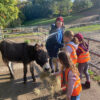
by Anna Dalglish
Kumon Guildford North Study Centre
Learning to read and write is just the beginning of a child’s journey towards mastering English. Even when a student can read accurately and fluently, this does not necessarily signify understanding (comprehension) of what is being read.
Comprehension is a key component of the primary school syllabus and is tested in both Year 2 and Year 6 SATS by requiring students to answer questions relating to passages of text.
Here are some ways you can help your child develop strong comprehension skills.
1. Ensure your child has fluent reading skills. The more challenging the task of reading, the more students struggle to understand what they are reading. Read every day with your child, familiarise yourself with the phonic sounds of each letter so you can assist them in ‘sounding out’ letters, and model how to blend the letter sounds together to create words.
2. A good vocabulary is essential for fluent reading and good comprehension. Encourage your child to look at context clues to work out the meaning of unfamiliar words. For example, “He sold his old car and bought a new vehicle.” With picture books, encourage your child to see if the pictures point to the meaning of a difficult word. You can also refer your child to cognate words (from the same linguistic root) or simpler forms of the word. For example, the word ‘criticise’ comes from the word ‘critic’. You can look up lists of words frequently used in SATS papers and make a game of learning the meaning and spelling of one word per day. Encourage your children to use sentences containing new words that they learn. If necessary, encourage your child to look up the meaning of any words they do not know.
3. Strong grammar skills help with understanding a passage of text and answering comprehension questions about it. Grammar rules are intended to improve communication and assist with comprehension of what is being communicated – for example, the main parts of speech (such as adjectives, nouns and verbs); conversion between active and passive voices; identifying the subject and object in a sentence; the use of commas to separate subordinate and main clauses.
4. Encourage your child to be an active reader. At the end of each paragraph, students should consider whether they have understood, and if not they should read the paragraph again. Each repeated reading will increase their understanding. Pause when reading with your child and ask questions – for example, “Why do you think he did that?”
5. It is helpful to visualise what is being read. In a fiction story, for example about a group of children exploring a cave, this will greatly increase your child’s enjoyment of what they are reading as well as helping with understanding. Even with non-fiction it is helpful to visualise. For example, with an article about fossils in the layers of sedimentary rocks, picturing the lower, middle and upper layers of rock will help with understanding.
6. Enable your child to identify where in the passage the answer is contained. Look for key words. For example, if the question asks, “What did Sam do after he fed the dog?” – look for the key words “after he fed the dog” (or similar) within the text and underline that part of the text. This helps students to focus and not be overwhelmed by seeking the answer in a long paragraph.
7. Decide what sort of question it is. Most questions can be classified into who, what, where, when, why or how? (5W’s and 1H), indicating what sort of answer is required. A ‘who’ question requires a name or description of a person, a ‘why’ question needs an answer including the word ‘because’, and so on.
8. When answering comprehension questions, answers must always be written in complete sentences and must stand alone without the need to refer back to the text. In response to a question, “Why did Sam open the door?” an incomplete sentence would read, “Because he was getting hot.” The correct answer is, “Sam opened the door because he was getting hot.” A helpful technique is to repeat the words of the question in the answer. In response to a question, “How did John know his father had gone out?” an incomplete answer would be, “He knew because his shoes were missing.” Although a complete sentence, this is not a complete answer – it begs the questions: “Who knew?”, “What did he know?” and “Whose shoes were missing?” A complete answer would be, “John knew his father had gone out because his father’s shoes were missing.”
Following these suggestions will help develop your child’s confidence in a skill which will support them not only in their study of English language and literature but in all their academic studies.
Anna Dalglish is the Maths and English Instructor at the Kumon Guildford North Study Centre, one of over 600 Kumon Study Centres nationwide.
For further information please visit www.kumon.co.uk











